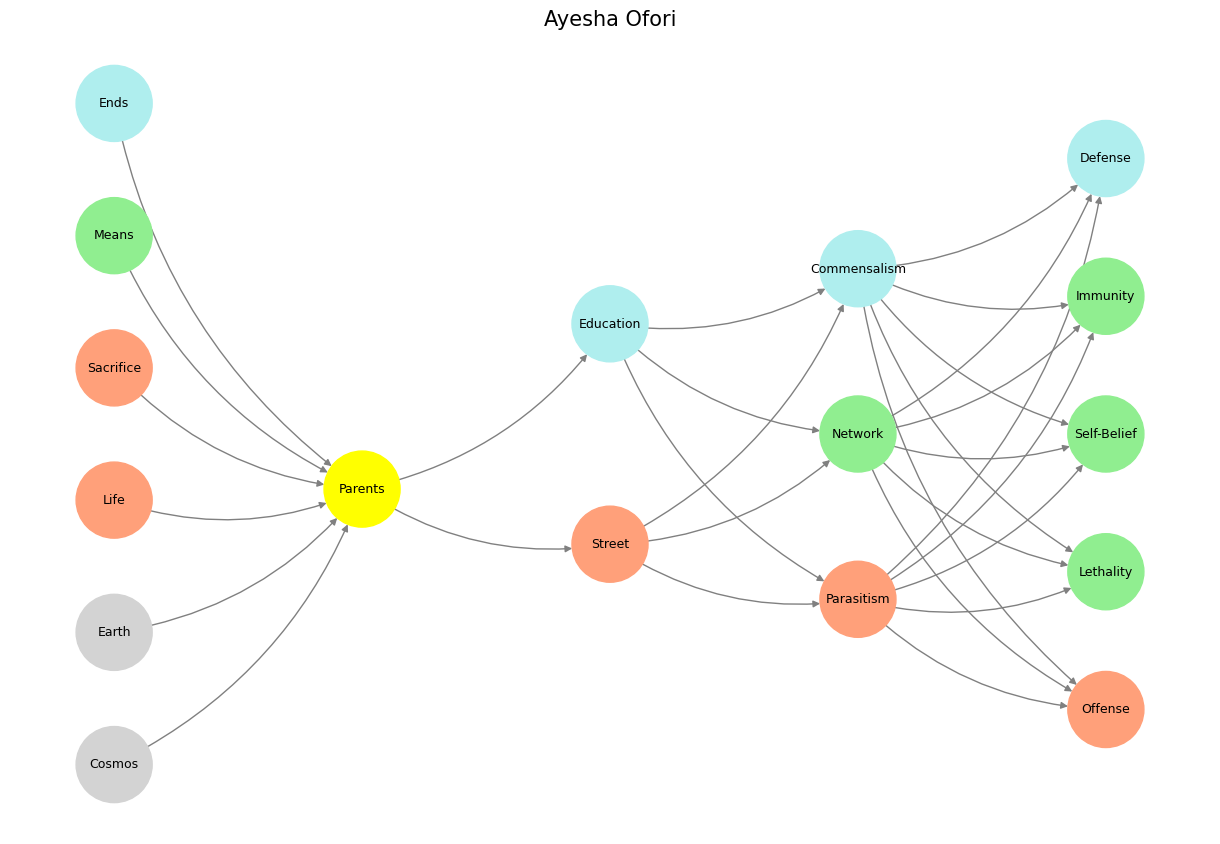Cunning Strategy#
Ayesha Ofori’s narrative, when mapped to a neural network with layers like Inheritance, World View, Decisions, Exposure, Launchpad, mirrors the essence of what neural networks embody: a layered approach to learning and adaptation. At its core, this structure emphasizes the pivotal role of inherited knowledge as the foundation upon which new learning builds. Just as neural networks refine their weights through exposure to data, individuals refine their decision-making and worldview through inherited wisdom, experiential inputs, and adaptive strategies.
The Inheritance layer reflects the wealth of data parents hold compared to their children—a concept universally acknowledged yet often contested in practice. Parents, acting as the “yellow node” of perception, provide a grounding force for nascent agents navigating the world. However, not all inheritances are equal; some are shaped by the streets or by self-education, pathways representing resilience and autonomy in the absence of traditional guidance.

Fig. 11 Competition (Generativity) & Feedback (Exertion). The massive combinatorial search space and optimized emergent behavioral from “games” among the gods, animals, and machines are the way evolution has worked from the beginning of time. Peterson believes reinforcement learning through human feedback (RLHF- a post-training twitch) removes this evolutionary imperative.#
Moving upward, the World View layer captures the interplay of cosmic and terrestrial influences—an individual’s understanding of the cosmos, the sacrifices they observe or endure, and the means and ends they come to value. Here, a child listening to a parent embodies cooperative learning, while navigating the streets signifies adversarial adaptation, aligning with neural network pathways that prioritize or suppress certain weights based on their environment.
The Decisions layer, encompassing agency, reveals how individuals balance parasitism, commensalism, and network-building. These choices are informed by exposure—whether to adversity, opportunity, or education—mirroring a neural network’s hidden layers, where dynamic reweighting of connections determines outcomes. For instance, education, shaded in “paleturquoise,” exemplifies a cooperative equilibrium where learning multiplies opportunities, whereas parasitism, “lightsalmon,” signifies adversarial survival strategies.
Ultimately, the Launchpad layer, analogous to a neural network’s output, represents physicality and action: offense, defense, self-belief, and immunity. It is here that decisions manifest into tangible outcomes, much like a neural network producing predictions or classifications after iterative learning. Nodes such as self-belief (“lightgreen”) and offense (“lightsalmon”) capture the dual forces of aspiration and survival, the tension between pursuing one’s dreams and defending against existential threats.
This layered framework resonates deeply with Ofori’s trajectory, where inherited privilege or hardship interacts with personal agency and exposure to opportunities, culminating in transformative actions. By grounding this narrative in the symbolic architecture of a neural network, we see a universal truth: both human lives and artificial systems depend on the interplay of inherited wisdom, environmental inputs, and iterative adaptation to forge their paths.
Show code cell source
import numpy as np
import matplotlib.pyplot as plt
import networkx as nx
# Define the neural network structure
def define_layers():
return {
'World': ['Cosmos', 'Earth', 'Life', 'Sacrifice', 'Means', 'Ends', ],
'Perception': ['Parents'],
'Agency': ['Street', 'Education'],
'Generativity': ['Parasitism', 'Network', 'Commensalism'],
'Physicality': ['Offense', 'Lethality', 'Self-Belief', 'Immunity', 'Defense']
}
# Assign colors to nodes
def assign_colors():
color_map = {
'yellow': ['Parents'],
'paleturquoise': ['Ends', 'Education', 'Commensalism', 'Defense'],
'lightgreen': ['Means', 'Network', 'Immunity', 'Self-Belief', 'Lethality'],
'lightsalmon': [
'Life', 'Sacrifice', 'Street',
'Parasitism', 'Offense'
],
}
return {node: color for color, nodes in color_map.items() for node in nodes}
# Calculate positions for nodes
def calculate_positions(layer, x_offset):
y_positions = np.linspace(-len(layer) / 2, len(layer) / 2, len(layer))
return [(x_offset, y) for y in y_positions]
# Create and visualize the neural network graph
def visualize_nn():
layers = define_layers()
colors = assign_colors()
G = nx.DiGraph()
pos = {}
node_colors = []
# Add nodes and assign positions
for i, (layer_name, nodes) in enumerate(layers.items()):
positions = calculate_positions(nodes, x_offset=i * 2)
for node, position in zip(nodes, positions):
G.add_node(node, layer=layer_name)
pos[node] = position
node_colors.append(colors.get(node, 'lightgray')) # Default color fallback
# Add edges (automated for consecutive layers)
layer_names = list(layers.keys())
for i in range(len(layer_names) - 1):
source_layer, target_layer = layer_names[i], layer_names[i + 1]
for source in layers[source_layer]:
for target in layers[target_layer]:
G.add_edge(source, target)
# Draw the graph
plt.figure(figsize=(12, 8))
nx.draw(
G, pos, with_labels=True, node_color=node_colors, edge_color='gray',
node_size=3000, font_size=9, connectionstyle="arc3,rad=0.2"
)
plt.title("Ayesha Ofori", fontsize=15)
plt.show()
# Run the visualization
visualize_nn()


Fig. 12 Nostalgia & Romanticism. When monumental ends (victory), antiquarian means (war), and critical justification (bloodshed) were all compressed into one figure-head: hero#

